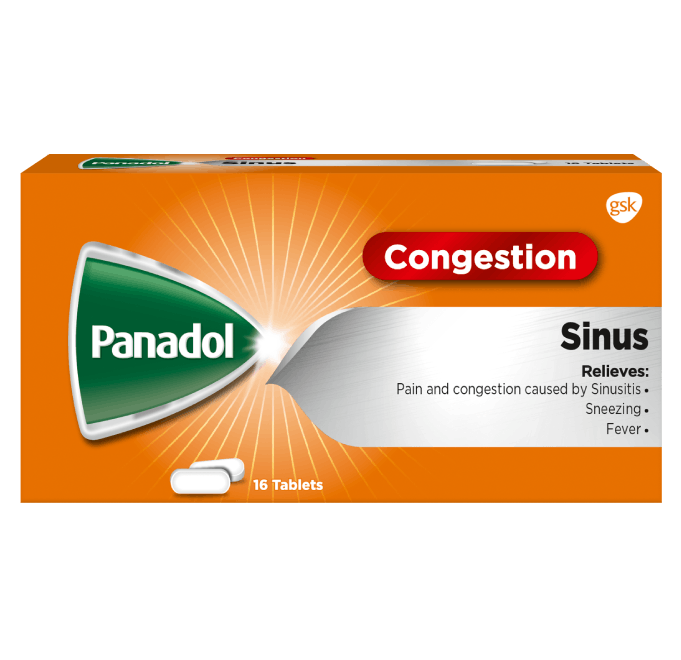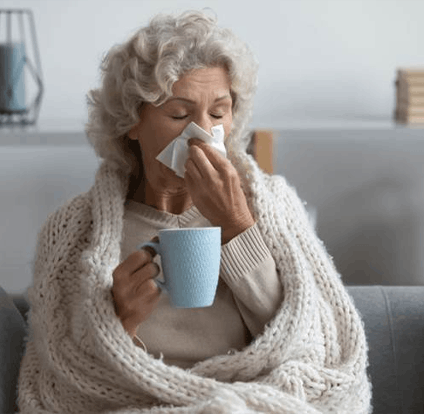The common cold, also known as the cold, is most commonly caused by the rhinovirus. However, the cold can be a complex condition since numerous viruses can cause it.1
The virus that causes the common cold enters the body through the mouth, eyes or nose. It can be spread through droplets in the air when someone who is sick coughs, sneezes or even talks. The virus can also be spread by hand-to-hand contact with someone who has a cold or by sharing contaminated objects, such as towels, utensils, telephones or toys.4
While there is no cure for the cold, multiple active ingredients, such as those contained in the Panadol Cold and Flu* portfolio of products, can help to relieve the symptoms.
In this article, we will cover the causes, diagnosis, treatments and signs to indicate that it’s time for you to visit your doctor.1
Signs that you have a cold
The cold is based on a set of relatively mild and self-limiting symptoms that are mainly located in the nose and throat.1
Cold symptoms usually appear between one to three days after exposure to the cold-causing virus. Initial symptoms are normally sore throat and runny nose,2,4 but, they can differ person to person. Most common cold symptoms are:1-4
Sore throat
Stuffy or runny nose
Cough and chest discomfort
Sneezing
Body aches and pains
Fatigue and weakness
Headaches, chills and fever are rare or uncommon, but can occur during the cold.
Most people recover from a cold in 7 to 10 days, but some symptoms may remain longer.
Beating the bug
For the most part, colds are annoying, but you can usually go about your normal daily routine. How long it takes to beat a cold depends on your lifestyle choices. There is no cure, but there are a few things you can do to lessen its symptoms and make yourself more comfortable.
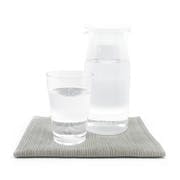
1. Drink, drink, drink
Get plenty of rest and drink lots of fluids to help you recover. Drinking plenty of fluids may help break up congestion, moisten the throat, ease a dry cough and prevent dehydration.1-2,5

2. Sip hot liquids
A hot drink or soup may help to moisten and soothe the upper airways and may also have a psychological benefit by providing a feeling comfort.5
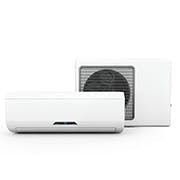
3. Moisten the air
Although there is no clinical evidence to support the benefit of humidifying the air, there is no harm in trying it.9 It is possible that dry air may further irritate a sore throat, and you might want to use a cool-air humidifier or vaporizer to eliminate dry air. Or, sit in a steamy bathroom for several minutes.1,5

4. Avoid irritants
If you’re a smoker, refrain from having a cigarette or being around secondhand smoke.1,4,7-8

5. Nasal irrigation
To relief nasal congestion and eliminate sticky mucus you can use a saline nasal spray.1,4,7-8
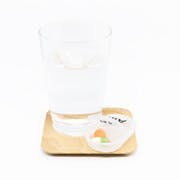
6. Seek relief from symptoms
Use over-the-counter medication for relief of the cold symptoms.1,2,5
Is important not only to feel well but also to protect ourselves and others from getting infected or spreading the cold viruses.
7. Wash your hands.2,3
Washing your hands is one of the most important ways to avoid getting sick and spreading germs to others. Scrub your hands frequently with soap and water. If soap and water are not available, use an alcohol-based hand sanitiser.2,4
8. Use tissues.2
Sneeze and cough into tissues. Discard used tissues immediately, then wash your hands thoroughly. Also, teach children to sneeze or cough into the bend of their elbow so that they do not spread germs with their hands. This is important when they do not have a tissue.2,4
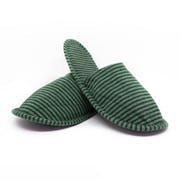
9. Try to avoid spreading the flu to others
Stay at home if you have the cold to avoid infecting others. With close people, avoid direct contact, like hugging, kissing or shaking hands.2
10. Keep surfaces clean.2
Clean kitchen and bathroom surfaces with disinfectant, especially when someone in your family has a cold. Avoid close contact with anyone who has a cold and do not share drinking glasses or utensils with other family members.2
Panadol's cold and flu helping hand
Over-the-counter cold and flu medicines, such as Panadol Cold & Flu, provides fast-acting and effective relief of cold symptoms, so that you can rest easily and get back on your feet.
According to the flu symptoms that you are experiencing you can select the best Panadol Cold & Flu product for you:
*For more detailed information, please refer to the product labelling. In case of doubt, please seek medical advice. Your pharmacist or doctor can help advise on the most appropriate treatments for you. If your symptoms persist or worsen, you should consult your doctor.
Take Panadol Cold & Flu products only as directed and always refer to label before use.
Do not take with any other products that contain the same active ingredient(s). Taking products containing any of the same active ingredients together may lead to an overdose. Immediate medical advice should be sought in the event of an overdose, even if you feel well.
Time to visit the doctor?
Is uncommon, but a cold can present with serious symptoms that may require medical attention. Here are some of the indications that you should see the doctor.1-2,4
1. You have difficulty breathing, feel short of breath, or are experiencing pain in the chest or abdomen.
2. You have a fever that does not go away, refuses to come down despite medication, or a fever with a rash.
3. Your symptoms (which may include fever, headache, nasal congestion or cough) persist or get worse.
4. You have severe or persistent vomiting.
5. You experience sudden dizziness or confusion.
References
- Centers for Disease Control and Prevention (2020, February 6). Common Cold. Available at: https://www.cdc.gov/antibiotic-use/community/for-patients/common-illnesses/colds.html
- Centers for Disease Control and Prevention (2019, February 11). Common Colds: Protect Yourself and Others. Available at: https://www.cdc.gov/features/rhinoviruses/index.html
- Centers for Disease Control and Prevention (2019, December 30). Cold Versus Flu. Available at: https://www.cdc.gov/flu/symptoms/coldflu.htm
- Mayo Clinic (2019, April 20). Common Cold. Symptoms & Causes. Available at: https://www.mayoclinic.org/diseases-conditions/common-cold/symptoms-causes/syc-20351605
- Mayo Clinic (2019, April 20). Common Cold. Diagnosis and Treatment. Available at: https://www.mayoclinic.org/diseases-conditions/common-cold/diagnosis-treatment/drc-20351611
- Mayo Clinic (2020, February 01). Sore throat: Diagnosis & Treatment. Available at: https://www.mayoclinic.org/diseases-conditions/sore-throat/diagnosis-treatment/drc-20351640
- Mayo Clinic (2019, February 16). Nasal congestion Basics: When to see a doctor. Available at: https://www.mayoclinic.org/symptoms/nasal-congestion/basics/when-to-see-doctor/sym-20050644
- Mayo Clinic (2019, June 21). Cough: When to see a doctor. Available at:https://www.mayoclinic.org/symptoms/cough/basics/when-to-see-doctor/sym-20050846
Related Products
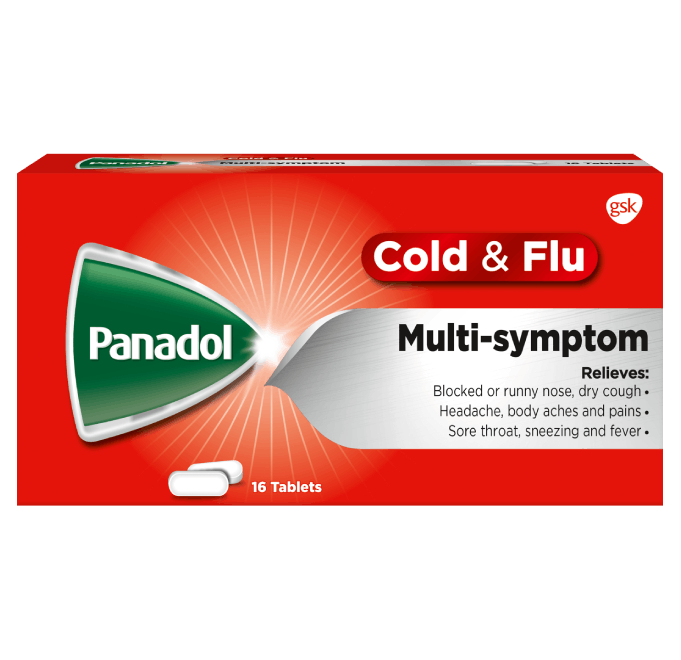
Panadol Multisymptom
Fights the bothersome cold & flu symptoms, including dry cough...



